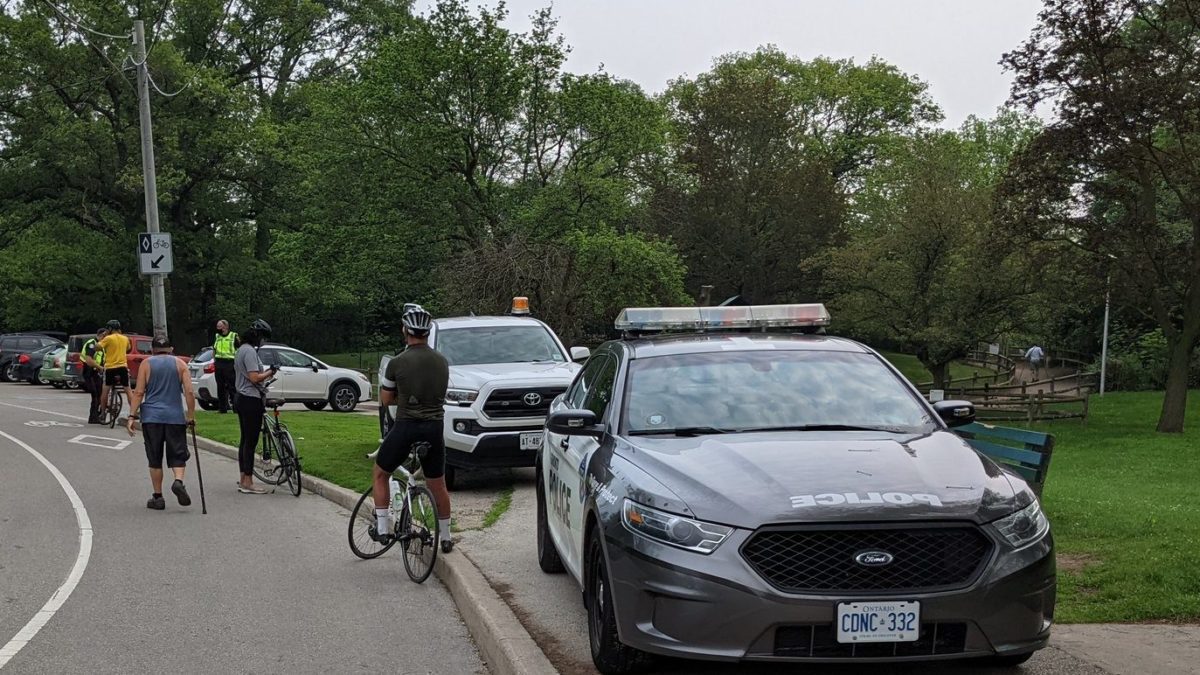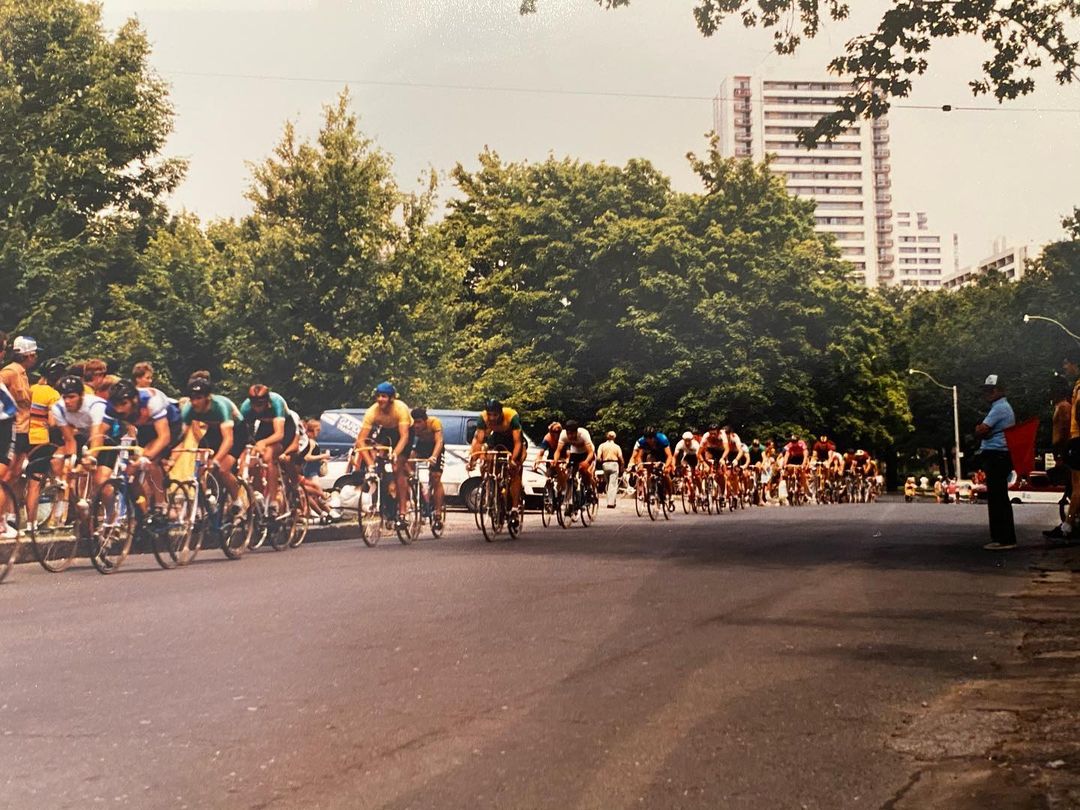Opinion: Cyclists shouldn’t get speeding tickets
There are better ways to allow all public park users to enjoy a space like Toronto's High Park
 Photo by:
WhitlaMike/Twitter
Photo by:
WhitlaMike/Twitter
I might be too close to the issue of ticketing in my go-to city park. I’m a Toronto road cyclist who loves High Park with its main centre loop. Still, I’ve struggled to put together an opinion on the ongoing debate around riding in that public space. The challenges involve pedestrians, cyclists, vehicles, confusing ticketing but, most important, I believe this issue comes down to the City of Toronto, and the importance of handling the influx of citizens trying to enjoy outdoor activities in a city not prepared to accommodate them.
High Park cycling
Cyclists are not new to High Park. In the 1980s, there was even a well-attended race that took place on the road that loops around the centre of the park.

When I started cycling more frequently in 2018, the 1.85km High Park loop was the default ride location. Don’t want to think about where to go? High Park loops. Have a workout planned? High Park loops. Easy social ride? Yes, High Park loops.
In the early hours of the morning, the park was almost always quiet. After-work loops were a bit of a gamble, but, on days when there weren’t events going on, the park was still relatively tame.
Things have changed in the past few years. As cycling and general outdoor activity exploded in popularity throughout the pandemic, High Park filled up with more people than I’d ever seen in the area before. I went to check it out on a cold day in the early spring—a time of year when normally the only people there would be myself and a few other cyclists sick of riding their trainers. Instead, the park was packed full of cars, pedestrians, casual cyclists and other forms of active transit.
Personally, that was where I drew the line. Cycling quickly around cars doesn’t bother me much, but riding at higher speeds around unpredictable pedestrians, runners and young cyclists who are learning to get comfortable on their bikes just doesn’t feel right. I’m genuinely happy that the park is getting more use—it’s truly one of my favourite places in Toronto. I think it’s great that people are spending more time exploring it, but I don’t feel comfortable cycling fast in that environment.
Ticketing
Although I hadn’t been to the park in a few months, the news of Toronto police officers giving tickets to cyclists riding in High Park still greatly upset me.
On July 19 and 20, 126 tickets were issued to cyclists and vehicles in High Park for speeding or not obeying stop signs. Sixty-two tickets were issued to cyclists and 64 to vehicles, costing them each a fine of $125.
According to the City of Toronto, the two-day enforcement blitz was held in response to complaints the city received regarding the “growing trend of cyclists and vehicles travelling at high rates of speed past children’s play areas such as splash pads, swimming pools and sports fields, and failing to obey the posted stop signs in the park.”
The speed limit, a blistering 20 km/h, was strictly enforced with these tickets, which were divided almost equally between motorized vehicles and cyclists.
Many of the riders have reported that they were commuting to work, or looking for a quieter way to get to the Martin Goodman Trail along Lake Ontario when they received speeding tickets at the bottom of a hill. Without speedometers, a number of the ticket recipients had no way of knowing they were riding faster than 20 km/h.
The tickets being issued to cyclists came with a $125 price tag, more than the cost of many used bikes. In order to get a speeding ticket that high you would have to driving at least?30km/h over the speed limit: https://t.co/W9lBNGvUXW @TheBikingLawyer #bikeTO https://t.co/2fosj6KUIE
— Ry Shissler (They/Them) (@RyShissler) July 26, 2021
The “enforcement blitz” offered no solutions for riders without speedometers. As an answer to how cyclists were supposed to know their speed, the City of Toronto simply said: “For their own safety, we urge cyclists to use caution, especially when travelling downhill and to always stop at stop signs.”
In an email, a representative for the city says that Toronto Police Services and the City of Toronto have worked together to implement “education and mitigation strategies.” This includes educating people about the speed limit, painting speed limits on roadways and erecting fencing to slow cyclists down at points during the Cherry Blossom closure.
Park laws
The Toronto-based Biking Lawyer LLP team says they were incensed to hear about the Toronto police pulling over and issuing speeding tickets to cyclists in High Park.
“Cyclists are healthy, fit, contributing members of society,” says David Shellnutt (known as “the Biking Lawyer.”) “Issuing tickets to cyclists demonstrates the misunderstanding of our choice of transportation and sport by those who run our city. Riding a bike is a healthy alternative. Bikes take cars off of roads and reduce congestion.”
Traffic tickets are a deterrent, he says. “Of what possible benefit is there to society of deterring the sport of cycling? The city should order police to focus their efforts of deterrence and resources on real threats – distracted drivers, road racers, crosswalk and streetcar light passers, bike lane parkers, and the list of actual harmful driver behaviour goes on. That is what kills people in our city – not health-conscious cycling enthusiasts. Ask yourself what is more dangerous: a bike travelling at 35 km/h or a 3-ton vehicle driven by someone looking at a phone?”
Shellnutt also points out that from 2006 to 2020, the Toronto police’s data shows one crash causing injury in High Park: a car hitting a cyclist. Of the 16,860 incidents from that time period, city-wide, there are only 35 involving both pedestrians and cyclists, with zero fatalities. Of those, injuries are listed as “none,” “minimal,” or “minor” 17 times.
“It’s time for Toronto to stop trying to police its way out of issues,” says Shellnutt. “Especially issues more appropriately left to the community to find fulsome solutions for. Sorry to say, but painting a speed limit on the ground isn’t the engagement or long-term strategy we need here to keep people safe.”
Overcrowding issues
Ticketing cyclists is not the solution. So what is?
I spent 30 agonizing minutes reading this Reddit post on the topic, in which /r/Toronto users came up with unhelpful suggestions such as: “There’s a velodrome just outside the city if you want to do that kind of thing.”
There are riders who push the limits of what is acceptable behaviour in the park, but the vast majority of local cyclists aren’t on time trial bikes hammering the High Park loop going 40 km/h at 6 p.m. on a Tuesday. They’re mostly riders looking for a space that’s relatively car-free to get some exercise safely and enjoy riding their bike in the city.
There should be space in the park for everyone—walkers, commuters and even cyclists who want to go a little bit faster. As outdoor activities, particularly cycling, have grown in popularity, public spaces such as multi-use trails or, in this case, High Park are becoming too crowded and the responsibility lands on the city to do something.
RELATED: What can be done about overcrowded multi-use paths?
It’s not unrealistic for Toronto to create an outdoor zone where cyclists are permitted to ride a bit faster. Montreal has the Circuit Gilles-Villeneuve and Vancouver has Stanley Park. It seems as though there may be whisperings of something somewhat similar in Toronto—the city is currently conducting a survey on High Park visitors and the travel network serving the park.
Currently, I’ve been riding loops at the CNE, but once events are back on, that space won’t be empty as it once was, leaving me and many Toronto road cyclists with nowhere to get in a quiet ride on a weekday morning or evening.
A petition and solution?
When I saw this petition from concerned mother Coline Berbesson, I assumed it would call for a cyclist ban or something of the sort. I was surprised to find that it made some good suggestions that could make a difference to the High Park problems in a way that ticketing random commuters could not.
Here is what Berbesson is asking of John Tory, Mayor of Toronto, and Gord Perks, Toronto city councillor for Parkdale-High Park:
– Offer more car-free hours during the week in addition to the weekends.
– A safe space can be created with a better separation. Cyclists who ride to exercise (fast lane), cyclists who like or learn to ride and runners (slow lane and larger than the fast lane) and pedestrians who enjoy walking (sidewalks).
– Paint the roads to get a better separation between the fast and slow lanes
– Add clear signs to ensure both cyclists and pedestrians are informed about the rules and respect them. Educational signs like “Pedestrians crossing,” “Cautious slow down pedestrians traffic,” “Bike route,” “Watch for cyclists” and electronic speed display signs.
– Reserve a time slot for cyclists to train between 6 a.m. and 8 a.m. at High Park. Casual cycling remains possible all day long.
– Get wider bike lanes on Martin Goodman Trail (Queensway part) with safe pedestrians crossings especially next to Sunnyside – Gus Ryder Outdoor Pool and Palais Royale.
– Build more and/or expand the existing infrastructures for cyclists. Possibly at Ontario Place or Exhibition grounds.
– Enforce the rules.
It’s not perfect, but any one of these propositions could help make a safer park for pedestrians and for cyclists. Ticketing commuters is not the solution.
